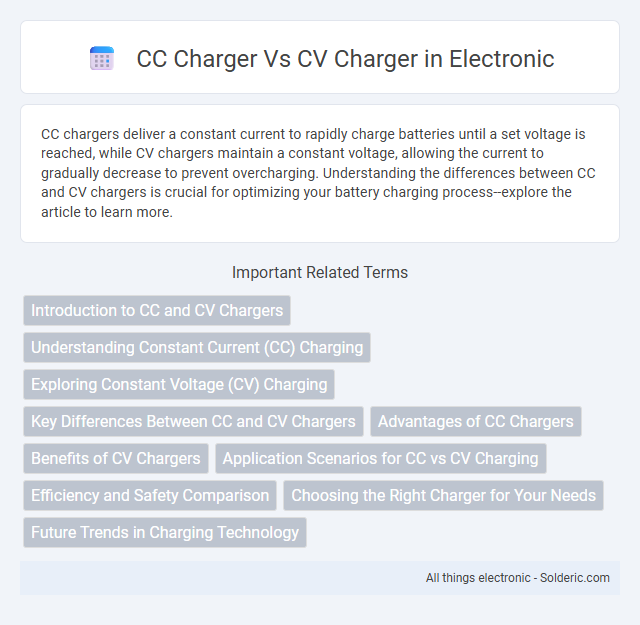CC chargers deliver a constant current to rapidly charge batteries until a set voltage is reached, while CV chargers maintain a constant voltage, allowing the current to gradually decrease to prevent overcharging. Understanding the differences between CC and CV chargers is crucial for optimizing your battery charging process--explore the article to learn more.
Comparison Table
| Feature | CC Charger (Constant Current) | CV Charger (Constant Voltage) |
|---|---|---|
| Charging Method | Delivers a fixed current regardless of voltage changes | Maintains a fixed voltage while current gradually decreases |
| Use Case | Ideal for initial battery charging phase to quickly restore charge | Used in the final charging phase to safely top off battery voltage |
| Battery Compatibility | Commonly used for lithium-ion and lead-acid batteries during bulk charge | Suitable for various rechargeable batteries to prevent overvoltage |
| Charging Efficiency | High efficiency during bulk charging phase | Ensures battery longevity by avoiding overcharge |
| Risk of Overcharge | Higher if voltage limits are not monitored | Low, due to controlled voltage limit |
| Typical Application | Battery packs, electric vehicles, power tools | Phone chargers, laptop power adapters |
Introduction to CC and CV Chargers
CC chargers deliver a constant current to your battery, ensuring a steady flow of electricity during the initial charging phase, which helps protect battery health. CV chargers, on the other hand, supply a constant voltage to maintain the battery charge at a set level once the battery reaches a certain voltage threshold. Understanding the differences between CC and CV charging methods is essential for optimizing your battery lifespan and charging efficiency.
Understanding Constant Current (CC) Charging
Constant Current (CC) charging supplies a steady current to the battery while allowing voltage to gradually increase, ensuring efficient and safe energy transfer during the initial charging phase. This approach prevents battery damage by avoiding excessive current that could overheat or degrade battery cells, making it ideal for lithium-ion and lead-acid batteries. CC charging is often paired with Constant Voltage (CV) charging to optimize battery lifespan by transitioning from a fixed current to a fixed voltage as the battery approaches full charge.
Exploring Constant Voltage (CV) Charging
Constant Voltage (CV) charging maintains a fixed voltage level throughout the charging process, adapting the current to prevent overcharging and ensure battery safety. Unlike Constant Current (CC) chargers that deliver a steady current, CV chargers gradually reduce current as the battery approaches full capacity, optimizing charge efficiency and extending battery lifespan. CV charging is particularly effective for lithium-ion batteries, where voltage control is critical for preventing thermal runaway and maintaining battery health.
Key Differences Between CC and CV Chargers
CC chargers provide a Constant Current output, maintaining a steady current flow during the initial charging phase to prevent battery damage, while CV chargers deliver a Constant Voltage output, stabilizing voltage as the battery reaches full charge to avoid overcharging. The key difference lies in their charging approach: CC chargers prioritize current regulation to control the charging rate, whereas CV chargers focus on maintaining voltage for safe battery saturation. Your choice depends on the battery type and charging requirements, as CC is suitable for early-stage charging and CV for the final phase.
Advantages of CC Chargers
CC chargers offer precise control over the charging current, reducing the risk of overheating and protecting battery health. They maintain a consistent current flow that ensures faster and safer charging, especially for batteries sensitive to voltage fluctuations. Your battery's lifespan can be extended by using a CC charger, as it prevents excessive current that could cause damage.
Benefits of CV Chargers
CV chargers provide consistent voltage output, making them ideal for charging devices with precise voltage requirements such as lithium-ion batteries. Their ability to maintain a stable voltage helps protect battery health by preventing overcharging and extending overall battery lifespan. You benefit from reliable and safe charging, especially in applications where voltage stability is critical.
Application Scenarios for CC vs CV Charging
CC chargers are ideal for lithium-ion batteries during the initial charging phase where a constant current is required to quickly charge the battery without overheating. CV chargers are used in the final charging stage to maintain a steady voltage and prevent overcharging, extending battery life and ensuring safety. Applications involving electric vehicles and portable electronics often combine CC and CV charging stages for optimal battery performance.
Efficiency and Safety Comparison
CC (Constant Current) chargers maintain a steady current output, optimizing battery charging efficiency by preventing overheating and excessive current flow. CV (Constant Voltage) chargers supply a consistent voltage, allowing the current to gradually decrease as the battery reaches full charge, which enhances safety by minimizing overcharging risks. Efficiency in CC chargers excels during the initial charging phase, while CV chargers provide safer, controlled charging in the final stage, balancing performance and battery lifespan.
Choosing the Right Charger for Your Needs
Choosing the right charger between a CC (Constant Current) charger and a CV (Constant Voltage) charger depends on your battery type and charging phase requirements. CC chargers supply a steady current until the battery reaches a specified voltage, making them ideal for initial charging stages, while CV chargers maintain a constant voltage, protecting the battery from overcharging during the final phase. Understanding your battery's specifications ensures you select a charger that maximizes lifespan and efficiency for your specific application.
Future Trends in Charging Technology
Future trends in charging technology emphasize the integration of adaptive CC (Constant Current) and CV (Constant Voltage) chargers to optimize battery health and reduce charging times. Advanced smart chargers will leverage AI algorithms to dynamically switch between CC and CV modes based on real-time battery diagnostics, enhancing efficiency for electric vehicles and consumer electronics. Emerging standards like ultra-fast charging protocols and wireless power transfer are expected to incorporate hybrid CC-CV mechanisms for improved energy management and extended battery lifespan.
CC charger vs CV charger Infographic

 solderic.com
solderic.com